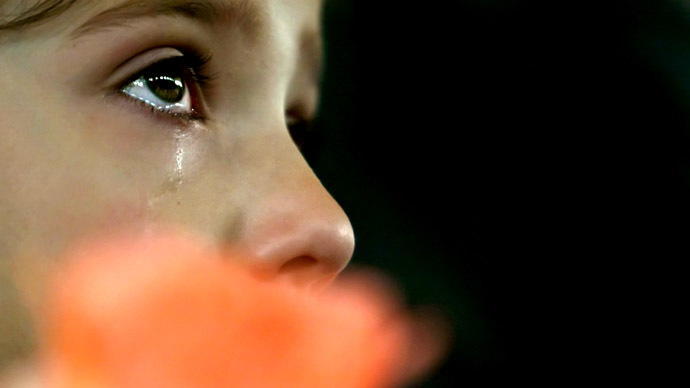Female genital mutilation in US tripled in 25 years

In the US, the estimated number of females between 15 and 49, who are either at risk of genital mutilation or who have already undergone a procedure, has reached more than 500,000, triple the amount reported in the 1990 national census.
The nonprofit Population Reference Bureau (PRB) said in a report released on Friday that the estimate stems from the 2013 American Community Survey from the US Census and concurrent analyses of immigrant communities and how common female genital mutilation (FGM) is in their home countries. PRB also considered that first- or second-generation American immigrants likely have or will have the same FGB rate as females in their native countries.
The nonprofit found that New York City and Washington, DC were the cities with the highest number of women impacted by FGB, with at least 50,000 females at risk in both. Minneapolis came in third based on its high Somali population.
According to the Guardian, unpublished data from the US Centers for Disease Control (CDC) and Prevention indicated that the number of females living with or at risk of FGM has gone up to 513,000 from 168,000 in 1997, mirroring PRB's estimate. The CDC was going to publicly release the figures on Friday, the 12th annual International Day of Zero Tolerance to FGM. The report was held, though, to finalize its preparation.
Today is International Day of Zero Tolerance for Female Genital Mutilation http://t.co/0DRdotZVeN#EndFGM@HRPresearch
— WHO (@WHO) February 6, 2015
The 168,000 estimate in 1997 was based on the most-recent US Census data available at the time, from 1990. In 2000, the African Women’s Center reported that 227,000 women were at risk or living with FGM ramifications, according to the Daily Beast.
“There are many more girls and women at risk of FGM than there were a decade ago, by the very nature of immigration coming from countries where it is carried out,” Charlotte Feldman-Jacobs, PRB’s program director for gender, told the Guardian.
“It’s very important to have these figures. Yes, there are laws in place but are we meeting the health needs of these women and girls? [These figures show] FGM is happening in New York, in Boston, it really brings it home that this is not just something that happens over there.”
On Zero Tolerance Day, we stand w/ the more than 125 million victims of female genital mutilation/cutting. Zero tolerance must be the norm.
— Susan Rice (@AmbassadorRice) February 6, 2015
FGM, a practice banned in the US in 1996, is “the partial or total cutting away of the external female genitalia … generally as one element of a rite of passage preparing young girls for womanhood and marriage,”according to the Guttmacher Institute. The procedure -- carried out for traditional, patriarchal purposes of control over female sexuality -- is often done under unsanitary conditions by someone without sufficient medical or anatomical knowledge.
“Despite these grave risks, its practitioners look on it as an integral part of their cultural and ethnic identity, and some perceive it as a religious obligation,” Guttmacher added. “Opponents of female genital cutting, however, emphasize that the practice is detrimental to women's health and well-being. Some consider female circumcision a ritualized form of child abuse and violence against women, a violation of human rights.”
The number of FGM cases can only be called an estimate since the practice is done in strict secrecy, as it is a felony in the US to admit to organizing a cutting.
Every girl deserves to grow up free of violence & discrimination. #EndFGM#TogetherforZerohttp://t.co/vjll0EoyZ3pic.twitter.com/qxXyAu3oUN
— United Nations (@UN) February 6, 2015
Feldman-Jacobs told the Daily Beast that sharing information on FGM data must improve for the issue to receive proper attention.
“How can we get better data?” she said. “We need to find out more about where they come from because if you look at maps on FGM, it’s not from all parts of all countries. If you take, for instance, the north of a particular country, it may have a 100 percent FGM rate, while another region of the same country has zero. So assuming a girl [from that country] has 100 percent been cut may be incorrect.”
Feldman-Jacobs added that FGM is actually on the decline overseas, by 50 percent in the past two decades.
The new measures announced today are further evidence of our commitment to #endFGMpic.twitter.com/WKz4BfzhkQ
— The Home Office (@ukhomeoffice) February 6, 2015
Twenty-two US states have instituted their own anti-FGM laws. Last year, the US Congress passed the Girls Protection Act, which closed a loophole that allowed girls to be taken to their home country to be mutilated, known as “vacation cutting.”
On Wednesday, US Reps. Joe Crowley and Sheila Jackson Lee announced a new bill that would push the US government to do more about FGM. The legislation called for a nationwide study on the practice and formation of a strategy to combat it with the help of teachers, healthcare workers, and law enforcement.
“In order to improve efforts to protect these little girls, we must know the facts about FGM in the United States,” Crowley said in a statement.












